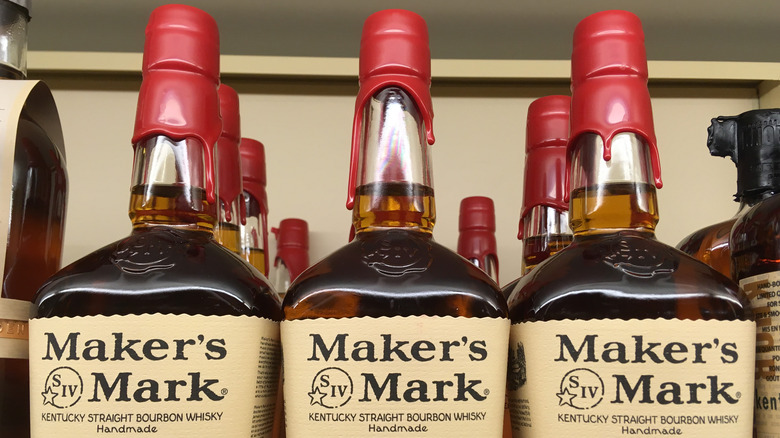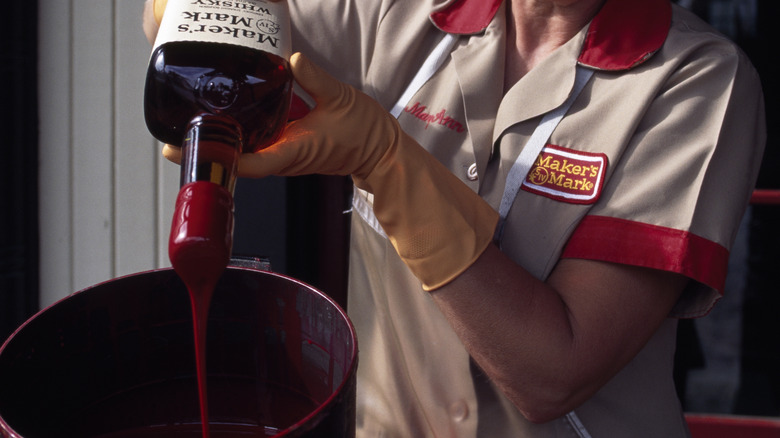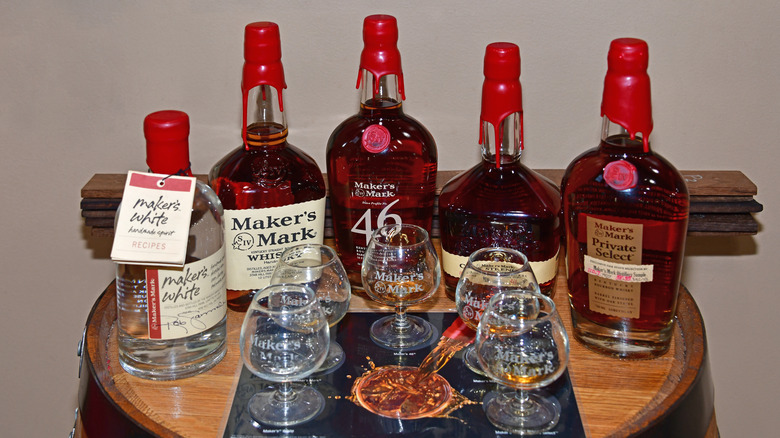How Maker's Mark Bourbon Got Its Iconic Red Wax Drip
Standing over the hot container wearing long protective gloves, I dipped my bottle of Maker's Mark bourbon into the molten red wax. It had looked easier when watching the workers doing it on the factory assembly line earlier in the tour of the Loretto, Kentucky distillery. While theirs had been a bit more uniform, mine was much messier, with the wax covering almost the entire neck. I swear Rob Samuels, the chief operating officer of Maker's Mark, gave my bottle's sloppy wax job a disapproving look when he signed its label.
After all, it was his grandmother, Margie Samuels, who came up with the idea for the iconic red wax, the bourbon's name, and the distinctive shape of its bottle, among many other aspects of the distillery's marketing. Back in the early 1950s, while Margie's husband, Bill Samuels Sr., was busy developing a new type of bourbon — one that turned out to be the key ingredient for making the best Old Fashioned — she was using her background as an artist and her business acumen to all but guarantee that Maker's Mark would stand apart aesthetically from any bourbon that had come before it. And the red wax on the bottle's neck was a big part of that.
Margie Samuels tested various colors and types of wax
Marge Samuels, who was known as Margie, came from a Kentucky bourbon-making family as did Bill Samuels, Sr., who she met at the University of Kentucky where she graduated with a chemistry degree. The couple married in 1937 and settled at Bill Sr.'s family home in Bardstown, Kentucky. It made sense that with their family ties to the bourbon industry and being from Kentucky, the bourbon capital of the U.S., with its bountiful corn crop and supply of limestone water, the couple would end up with a distillery of their own. In 1953, they began work on the bourbon that Margie would name after the maker's mark — akin to an artist's signature — found on fine English pewter, which she collected. The idea for the wax-covered neck came from traditional cognac bottles.
Per the Lexington Herald-Leader, Margie's son Bill Jr., recalled his mother taking over his makeshift photo lab in the basement of the family home to work on her wax-making project. She put her chemistry degree to work and eventually came up with the formula for the resilient, shiny wax and hand-dipping technique still used today. She and her husband settled on the distinctive red color of the wax to help the brand stand out. Margie also came up with the bottle's label, including its font. It all made for one unique package with the red wax acting as the exclamation point.
Maker's Mark trademarked its wax
The first bottle of Maker's Mark with the red wax landed on store shelves in 1958 and its unique look quickly helped set the brand apart from its competitors. Because Maker's Mark uses this hand-dipping wax process, the company can't produce as many bottles per hour — making only around 100 to 200 instead of 200 to 400 — and it adds production costs, but it's hard to imagine the brand without this distinctive topper.
Margie Samuels' dripping red wax was so unusual looking that Maker's Mark was able to trademark it in 1985. The company successfully sued Diageo, which at the time distributed the Jose Cuervo tequila brand, in the mid-2000s for trademark infringement after it released a high-end line of tequila featuring a similar red dripping wax top. Margie's marketing genius prevailed. I even have Margie Samuels to thank for getting to visit the Maker's Mark distillery and others that I've toured. She's credited with coming up with the idea of bourbon distillery tourism. Let's raise a glass to her with our exclusive cocktail recipe, a Maker's Mark and vanilla tomato water cooler.


